If you like a little bit of berry fizz in your life, you will love this naturally probiotic fermented lemonade with fresh berries. Sexy it up with cherries and tarragon, and we have ourselves a perfect summer drink or cocktail base or healthy homemade soda.
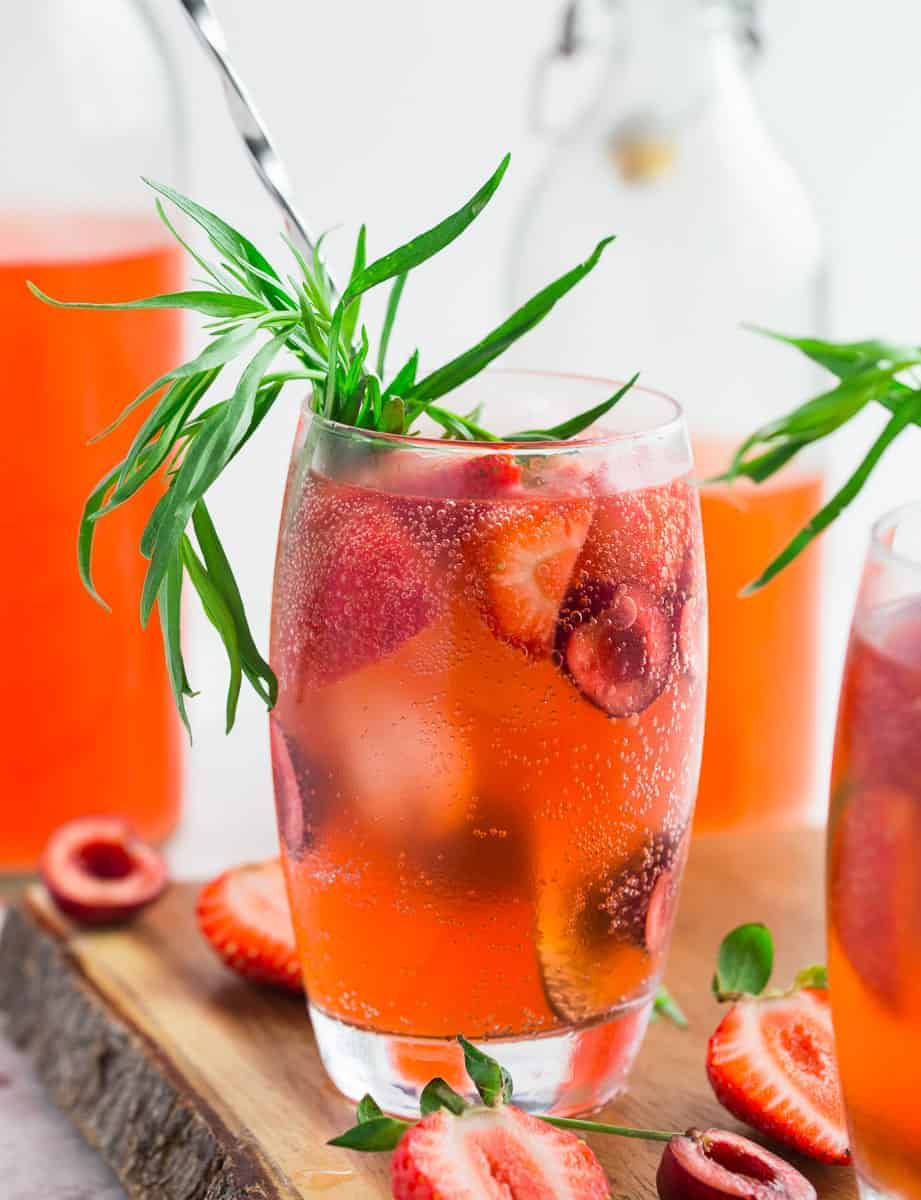
Jump to:
If you made my recipe for citrus lemonade or strawberry lemonade, you know how good it is and will probably find it hard to believe it can get better.
Well, yes it can. And, the best part is it won't require much effort from you.
Instead, the natural yeast present on the strawberries will do all the hard work for you and turn this into delicious fermented lemonade.
What is fermentation
Fermentation is the process where microbes turn foods or drinks into something else even more desirable.
When the correct microbes "consume" and "digest" sugars they produce beneficial by-products that help transform foods into something healthy, delicious and useful to us.
There are different types of microbes responsible for different ferments. Fermented lemonade is a wild yeast fermentation but also has healthy probiotic bacteria like lactobacillus and acetobacter.
These microbes all prefer a slightly acidic environment while bad bacteria can't stand it. Giving us the perfect opportunity to let the good gut-healthy bacteria thrive.
Types of everyday fermented foods include the following.
- Sriracha made from fermenting chillies.
- Wine from fermented grapes.
- Beer from fermented malted grains.
- Classic pickled cucumbers.
- Sauerkraut from fermented cabbage.
- Soy sauce from koji.
Useful equipment
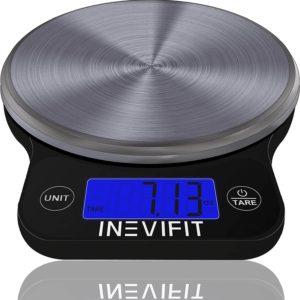
Electronic Kitchen Scales
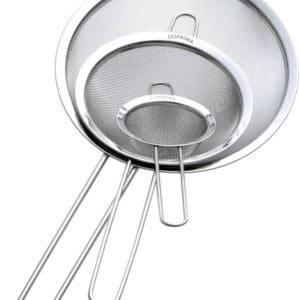
Fine Mesh Strainers
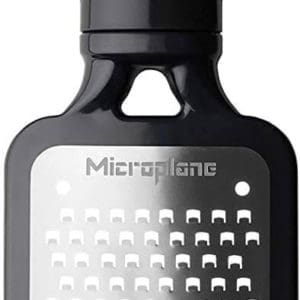
Microplane Grater
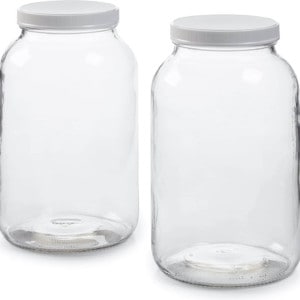
Fermentation jars
Preparing your equipment
There is one golden rule when it comes to fermenting anything.
Cleanliness.
You mess that up and any ferment will turn bad. The dark side is much stronger when it comes to microbes when you give them the opportunity.
For fermented strawberry soda, it's fine to just make sure everything is washed with soap and water including your hands.
You will need:
- A 3-litre glass jar
- 4 x 500ml swing top bottles
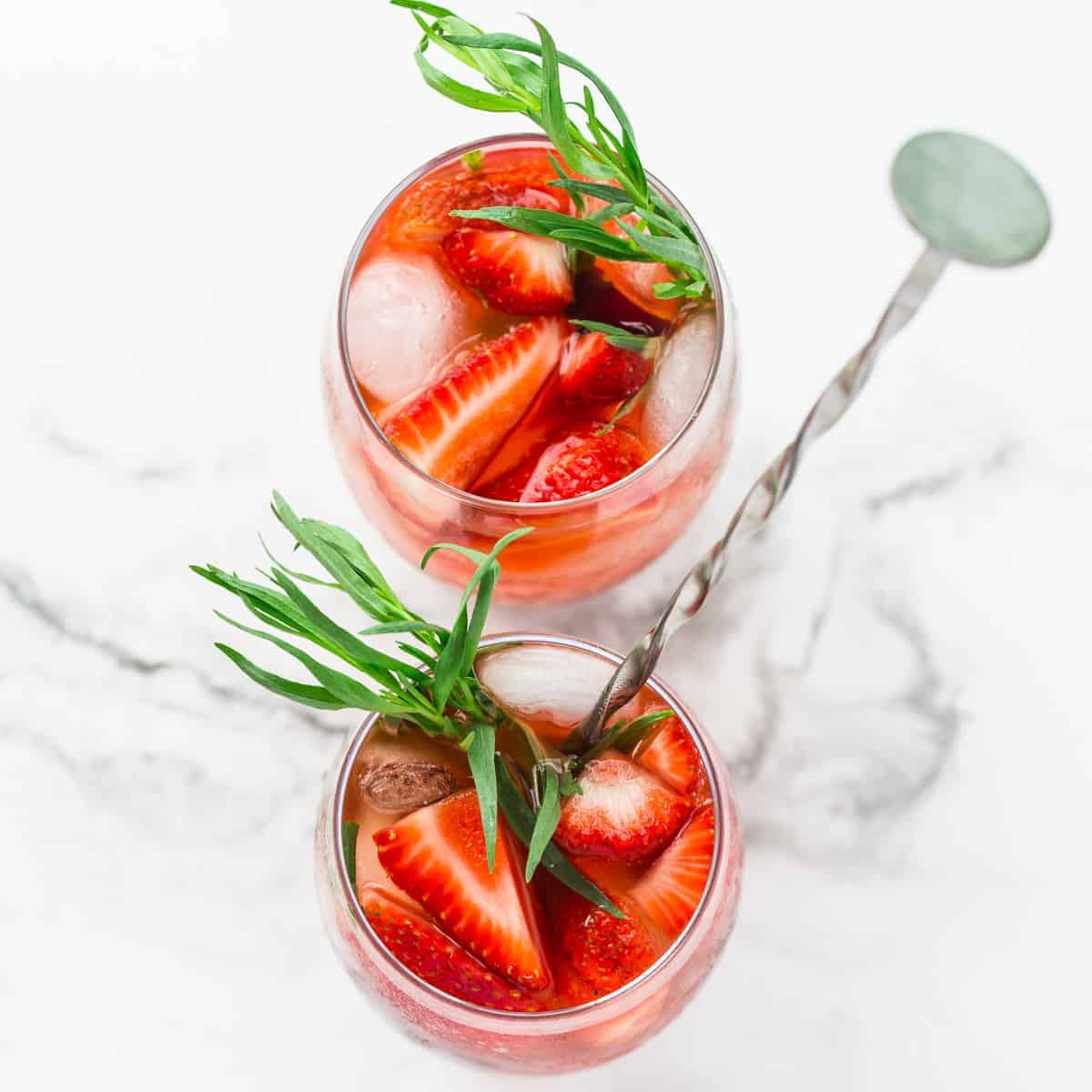
Ingredients needed
For the fermented lemonade, we will start by using the strawberry lemonade ingredients as a base and just let it naturally ferment.
When that's done we will do a secondary in-bottle ferment where the soda gets naturally carbonated and also take on the flavour of the tarragon.
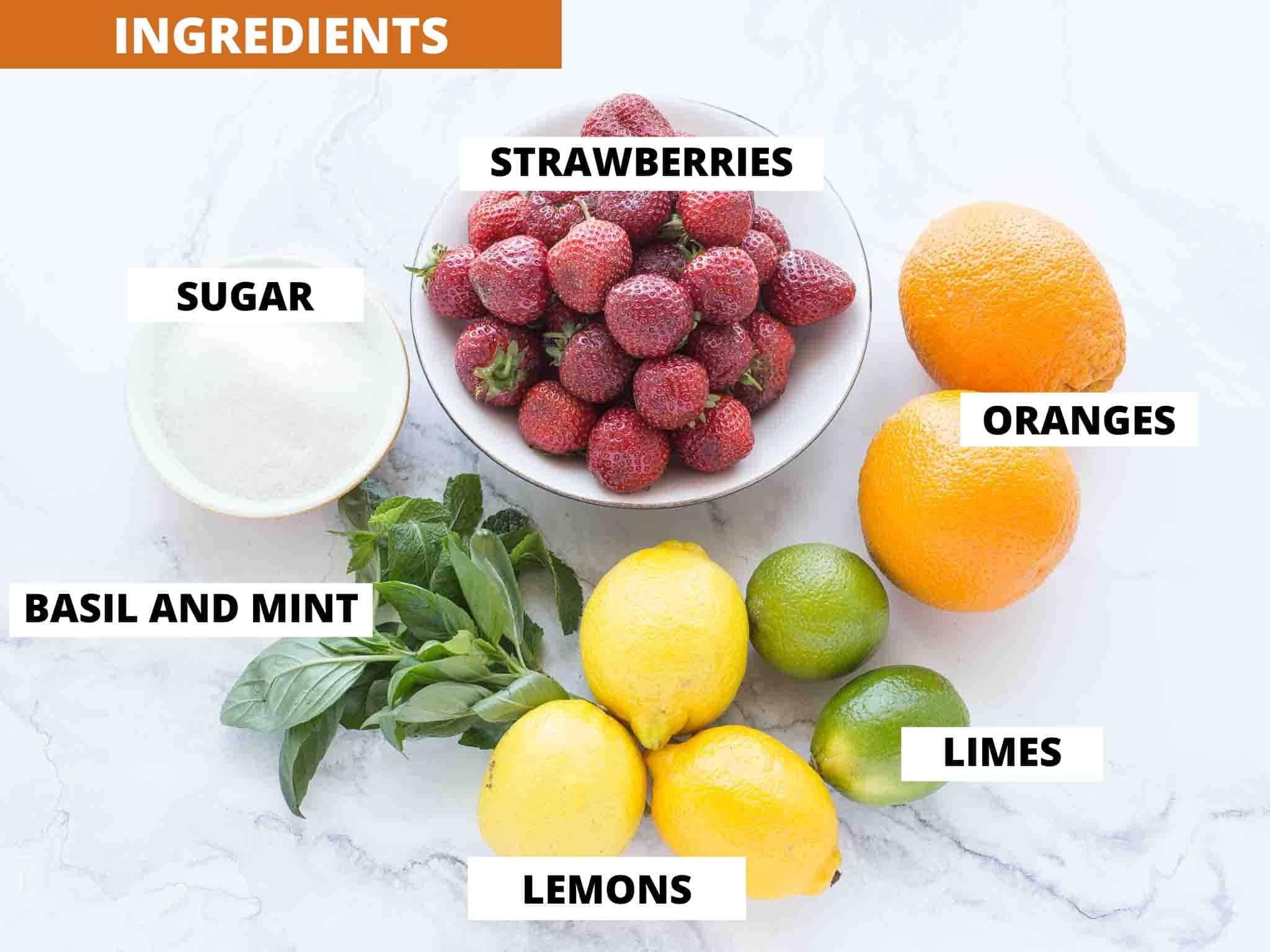
- Strawberries - Use unblemished fresh ones. Fermentation can not bring dead strawberries back to life.
- Citrus - Oranges, limes and lemons.
- Sugar - Regular white granulated sugar
- Herbs - Mint and basil for the first ferment then tarragon for secondary fermentation and garnish.
- Cherries - Optional but good.
- Water - Clean drinkable tap water is fine.
How to make it
Making fermented lemonade happens in a few stages. None of which are hard to do or require any specific skill.
Step 1: Make the base
- Wash the citrus and strawberries thoroughly under cold running water.
- Bring to the boil 250g water and 250g sugar until dissolved. Zest as much citrus as the recipe calls for and add it into the hot sugary water along with a few sprigs of fresh mint and basil. Add 1750g of cold water to cool the liquid down along with the citrus juice.
- When infused strain through a sieve into a suitable 3-Litre container.
- Cut 500g strawberries in half and add to the "lemonade". Cover the container with a loosely fitting lid, plastic glove or lid with an airlock.
Step 2: Ferment it
- Let the mix ferment at a temperature between 21°C or 77°F and 30°C or 86°F. The time it takes will depend on the temperature. Colder slower and hotter quicker. Mine fermented in 4 days with a day temperature of 27°C or 80°F and night temperature of 18°C or 64°F. You might see some calm yeast form on the top of the surface. It's a white layer that looks almost like mould but it's harmless. If you're not sure then send me a pic on Instagram and I will tell you if it's ok or not.
- Once fermented it should taste less sweet as the yeast consumed most of the sugars. It should have a slight fizz and fragrant ripe almost wine-like strawberry aroma.
Step 3: Bottle it
- Strain the fermented strawberry liquid through a sieve and pour into 500ml swing-top bottles along with a teaspoon or 4 grams of sugar. This is so that the yeast has enough sugar to ferment in order to produce carbon dioxide as a by-product which in turn carbonates the soda. Add in a few sprigs of tarragon too.
- Close the bottles and leave at room temperature for another 3-4 days.
- Test one bottle by opening it to see if it's nice and fizzy. If not close and let it go for longer. If it's nice and bubbly then chill it well for a few hours in the fridge before drinking.
Carbonation fact
Gass leaves chilled liquids way slower than warm liquids. Which is why you should always keep sparkling wine very well chilled to avoid it going flat too quickly.
The same goes for any other carbonated drink. Especially naturally carbonated like this soda.
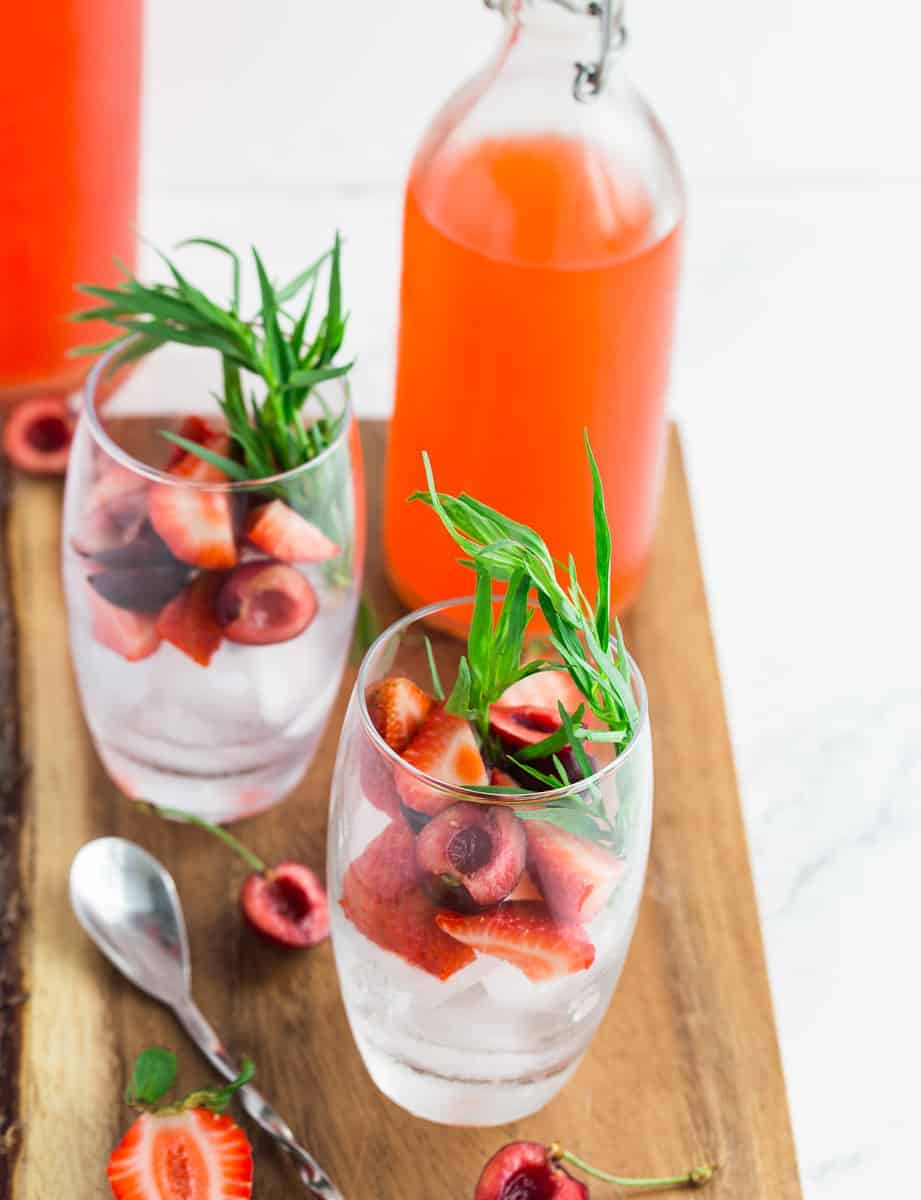
Variations
You could make a few simple adjustments to this fermented strawberry soda recipe in order to get completely different results.
- Berries and fruit- You can use any berry, cherry or fruit your heart desire. Berries with smooth skins like blueberries, currants and cherries generally have more natural yeast than porous ones like blackberries, strawberries and raspberries. Other fruits like apricot, peach and plums are all great contenders.
- Citrus - We need the citrus to lower the Ph level in order for the soda to safely ferment. So pick at least one or use sour berry juice like sea buckthorn or red currants. Citrus is much easier to come by and also less expensive.
- Herbs - You can totally leave out the herbs if you like or play around with things like elderflower, lavender, rosemary, or lemon verbena.
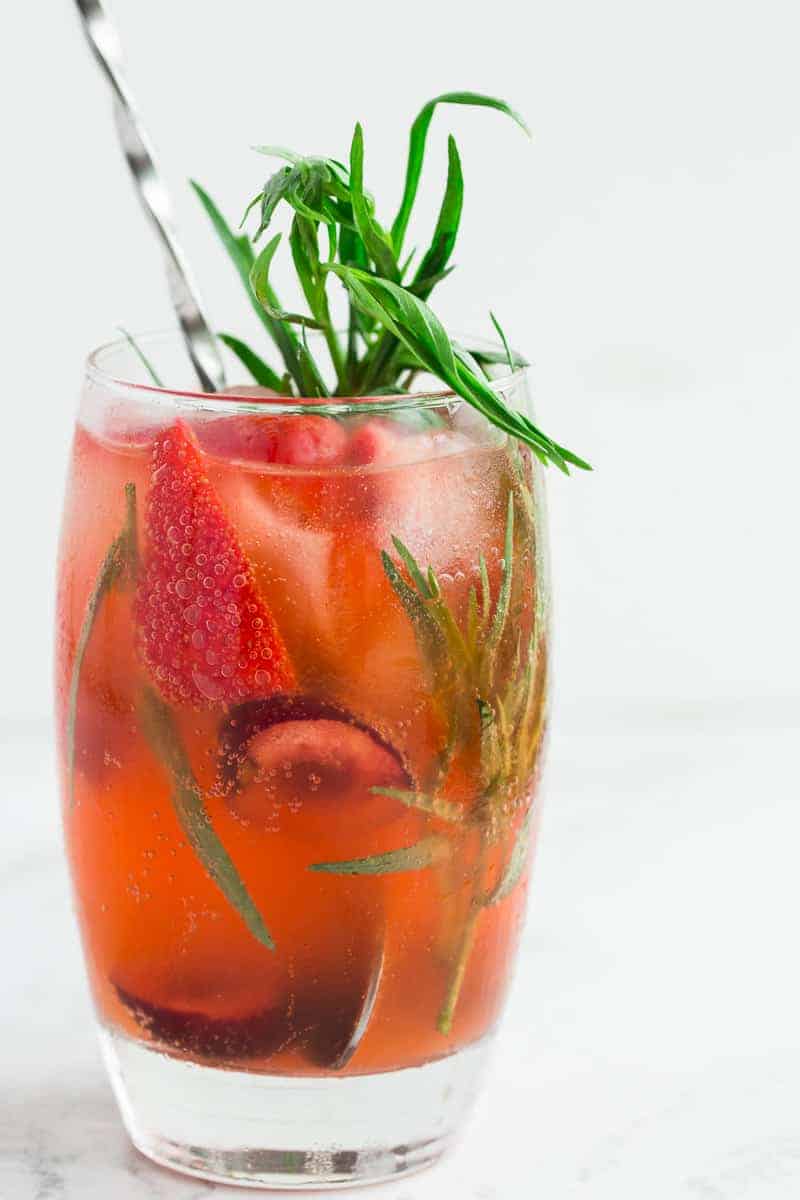
Frequently asked questions
Yes, by following the correct method like I've shown you and creating a favourable environment for good probiotic bacteria, naturally fermented drinks are safe for consumption. And also good for you.
Only trace amounts. Not enough to be considered an alcoholic drink.
You should keep it stored in the fridge. Because it's a live unpasteurised ferment it will keep on fermenting even in the fridge although at a very slow pace.
It will stay fresh for about 2 weeks stored in the fridge. Make sure to let out a bit of gas from the bottles now and then if needed, to make sure the pressure does not build up too much.
Related recipes
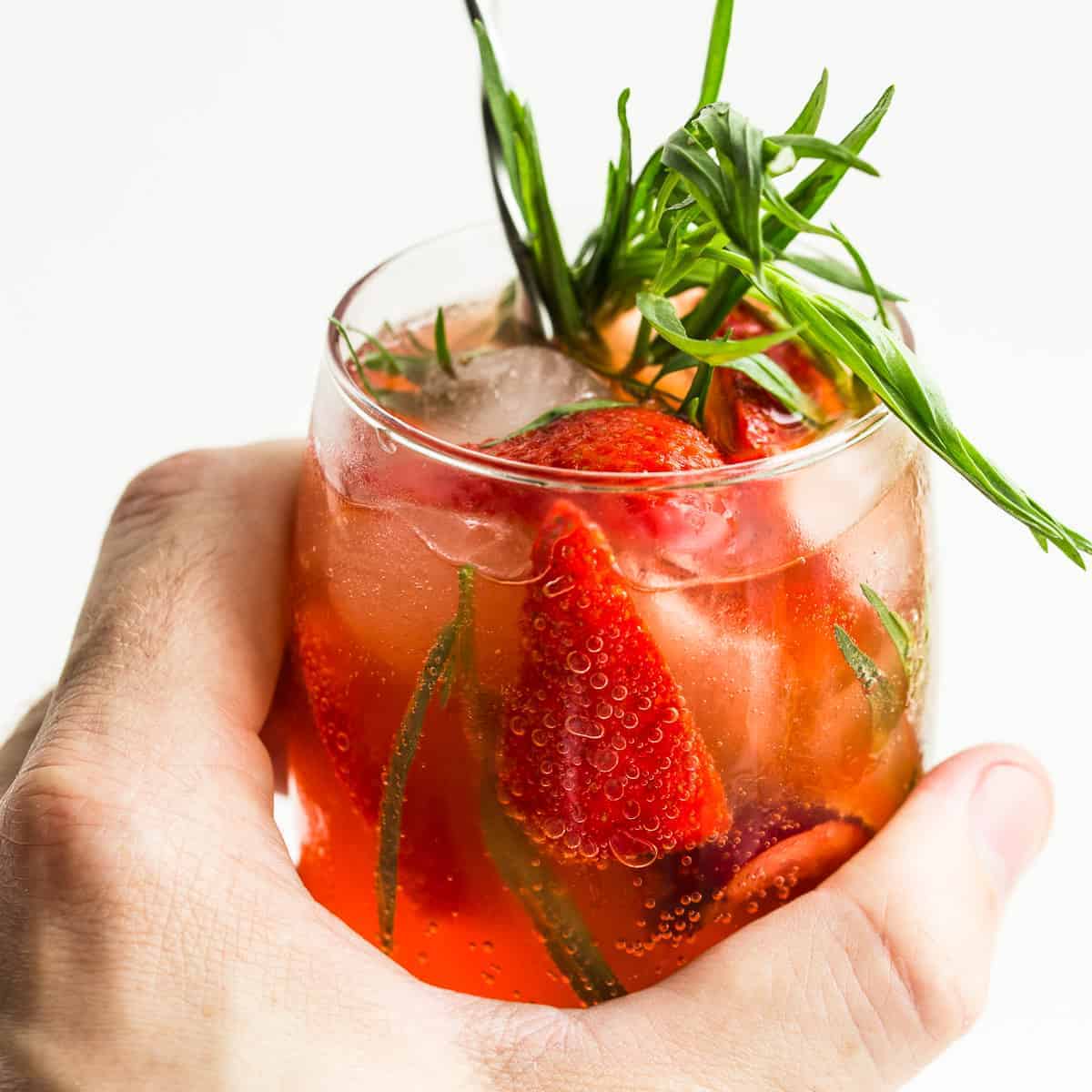
This site contains affiliate links. I may earn a tiny commission on qualifying purchases at no extra cost to you. By bookmarking these links you help support the upkeep of this site.
If you found this post helpful or have learned something, comment, subscribe, and follow me on social platforms for more tasty recipes.
Recipe
Fermented Strawberry Lemonade
Ingredients
For the base
- 250 g (1 ¼ cups) sugar
- 2 L (½ gal) water
- 15 g (2 ½ tablespoon) lemon zest
- 15 g (2 ½ tablespoon) orange zest
- 10 g (1 ⅔ tablespoon) lime zest
- 180 g (¾ cups) lemon juice
- 60 g (¼ cups) lime juice
- 160 g (⅔ cups) orange juice
- 10 g (2 tablespoon) fresh mint sprigs - optional
- 10 g (½ cups) red basil - optional
- 10 g (½ cups) green basil - optional
To add before 1st fermentation
- 500 g (3 ½ cups) strawberries
- 25 g (3 ½ tablespoon) tarragon
To add at bottling and 2nd ferment
- 20 g (1 ⅔ tablespoon) sugar
To serve
- 200 g (1 ½ cups) strawberries
- 200 g (1 ½ cups) black cherries
- 100 g (½ bunch) tarragon
Instructions
Make the base
- Wash the citrus and strawberries thoroughly under cold running water
- Bring to the boil 250g water and 250g sugar until dissolved. Zest as much citrus as the recipe calls for and add it into the hot sugary water along with a few sprigs of fresh mint and basil.
- Add 1750g of cold water to cool the liquid down along with the citrus juice. Let it infuse for 30 minutes to an hour.
- When infused strain through a sieve into a suitable 3-Litre container.
- Cut 500g strawberries in half and add to the "lemonade".
- Cover the container with a loosely fitting lid, plastic glove or lid with an airlock.
Ferment it
- Let the mix ferment at a temperature between 21°C or 77°F and 30°C or 86°F. The time it takes will depend on the temperature. Colder slower and hotter quicker. Mine fermented in 4 days with a day temperature of 27°C or 80°F and night temperature of 18°C or 64°F. You might see some calm yeast form on the top of the surface. It's a white layer that looks almost like mold but it's harmless. If you're not sure then send me a pic on Instagram and I will tell you if it's ok or not.
- Once fermented it should taste less sweet as the yeast consumed most of the sugars. It should have a slight fizz and fragrant ripe almost wine-like strawberry aroma.
Bottle it
- Strain the fermented strawberry liquid through a sieve and pour into 500ml swing-top bottles along with a teaspoon of sugar. This is so that the yeast has enough sugar to ferment in order to produce carbon dioxide as a by-product which in turn carbonates the soda. Add in a few sprigs of tarragon too.
- Close the bottles and leave at room temperature for another 3-4 days.
- Test one bottle by opening it to see if it's nice and fizzy. If not close and let it go for longer. If it's nice and bubbly then chill it well for a few hours in the fridge before drinking.
To serve
- Fill a few well-chilled glasses with ice and add some cherries and strawberries along with more fresh tarragon. Pour and enjoy straight away.
Notes
- You can change the fruit used in this recipe to any other fruit like apricots, peaches, other berries or plums.
- Do not let it over ferment or forget about it at room temperature as the bottles could explode if the pressure builds up too much. This happens extremely rarely but I have to say it.

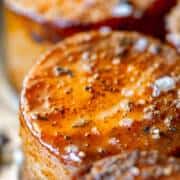
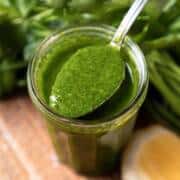

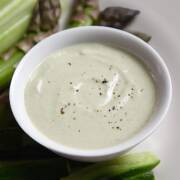
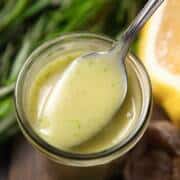
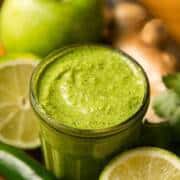
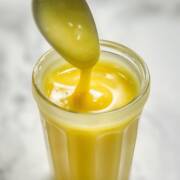


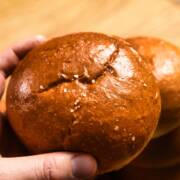
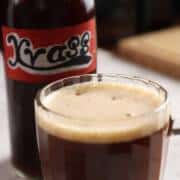
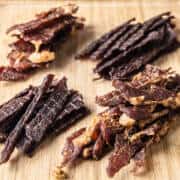
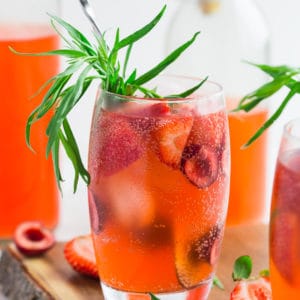
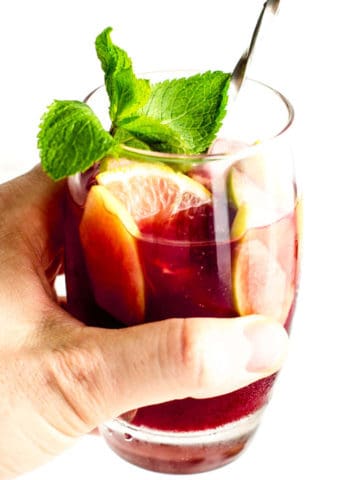
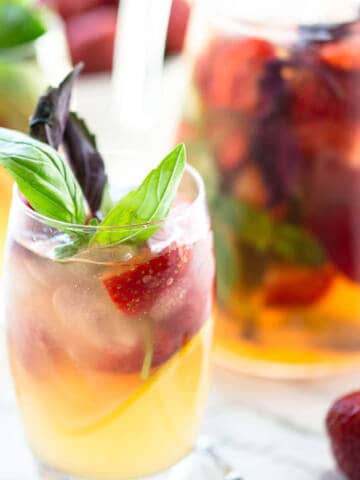
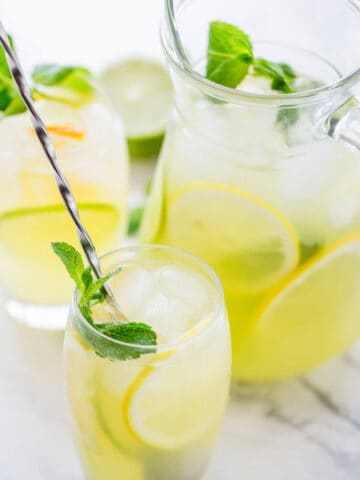
Neil
Can I add any fruit to this and make a fermented lemonade? What if I add a kombucha scoby?
Charlé Visser
Yes, you can use any fruit. Just make sure to wash it well and it should be unblemished. Add a SCOBY yes, but remember to add some of the liquid that comes with the SCOBY or some unpasteurized kombucha to kickstart it.
N
This sounds delicious! What pH should it be for best fermentation?
Thank you for the recipe!
Charlé Visser
It can go lower, but aim for Ph of 3,5 to 4.
Gail
I came here when I accidentally left my container of lemonade with fresh strawberries out for two-days. The lid was under a bit of pressure when I opened it, so I was afraid I had wasted all of my pink lemonade. Well, this recipe gave me hope that I could safely enjoy my new and improved concoction! As the author stated, the liquid takes on a wine-like aroma. I absolutely enjoyed the flavor, and I even felt the calming effects of the fermentation. I'm so happy that I found this site!